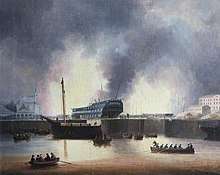HMS St George (1840)
HMS St George was a 120-gun first rate ship of the line of the Royal Navy, launched on 27 August 1840 at Plymouth.[1]

The Fire on the morning of 27 September, 1840, which threatened to destroy the dockyard. St George pictured was far enough away from the blazing Talavera to escape destruction.
 HMS St George and Arethusa on the Hamoaze near Bull Point, by Edward Snell (engineer) | |
| History | |
|---|---|
| Name: | HMS St George |
| Ordered: | 27 May 1819 |
| Builder: | Plymouth Dockyard |
| Laid down: | May 1827 |
| Launched: | 27 August 1840 |
| Fate: | Sold, 1883 |
| General characteristics [1] | |
| Class and type: | Broadened Caledonia-class ship of the line |
| Tons burthen: | 2694 bm |
| Length: | 205 ft 5.5 in (62.624 m) (gundeck) |
| Beam: | 54 ft 6 in (16.61 m) |
| Depth of hold: | 23 ft 2 in (7.06 m) |
| Propulsion: | Sails |
| Sail plan: | Full rigged ship |
| Armament: |
|
While in the dockyard and before being put to sea she was at risk of destruction. The dockyard suffered severe damage in a large scale fire on 25 September 1840, it started in the North Dock on HMS Talavera and Imogene were completely gutted, threatened the HMS Minden, and spread to nearby buildings and equipment. Estimates for the damage were put at £150,000 in the values of the day, and would have totalled £500,000 had the fire not been contained by demolishing several surrounding buildings.[2]
She was fitted with screw propulsion in 1859, and was sold out of the service in 1883.[1]
Notes
- Lavery, Ships of the Line vol.1, p190.
- "Dreadful Fire at Devonport". London: The Morning Chronicle. 25 September 1840. Archived from the original on 17 March 2019. Retrieved 26 April 2020.
gollark: Well, in a very real sense, Apple bad.
gollark: It's too cold and also has no nutritional value at all.
gollark: It's not hacking if you literally give someone else your login.
gollark: Anyway, yes, just don't share your password?
gollark: > I mean none of the accounts are based on my IP anyway... what?
References
- Lavery, Brian (2003) The Ship of the Line - Volume 1: The development of the battlefleet 1650-1850. Conway Maritime Press. ISBN 0-85177-252-8.
- Lyon, David and Winfield, Rif (2004) The Sail and Steam Navy List: All the Ships of the Royal Navy 1815-1889. Chatham Publishing, London. ISBN 1-86176-032-9.
This article is issued from Wikipedia. The text is licensed under Creative Commons - Attribution - Sharealike. Additional terms may apply for the media files.